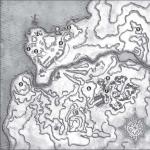How to choose the right coniferous plants for an alpine slide. The choice of conifers for the alpine hill Alpine hill with juniper
Creating an alpine slide is a fascinating process that requires not only imagination, but also attentiveness. Even one incorrectly selected plant can spoil the whole impression, breaking the harmony between other inhabitants of the rocky garden. Therefore, you need to do right choice from an extensive list of plants suitable for composing an alpine slide.
To make the alpine slide look attractive throughout the season, you should select a place for planting plants, taking into account their flowering time and the principle of layering:
- The top of the hill. It is more open to the sun's rays than the tiers below; therefore, it is rational to plant plants here that love sunlight and not in need of in large numbers moisture.
- middle tier- a place for plants that feel good in partial shade. Here, the average soil moisture, so the middle of the alpine hill can be called universal: milking most flowers here ideal conditions which gives you a wide range of choices.
- The foot of the hill- the logical conclusion of the landscape composition. The plants planted here should be combined with the rest of the rock garden and choose those that love moisture and tolerate shade. After all, most of the sun's rays will go to the neighbors from above.
To provide continuous flowering from early spring to late autumn, flowering plants should be selected according to the principle of rotation. Evergreen shrubs and dwarf trees will look great in winter, looking out from under the snow.
Creating an alpine slide is a fascinating process that requires not only imagination, but also attentiveness
Plant layouts in rock gardens
Before you start creating an alpine slide, you need to create a graphic scheme. It will reflect the general idea of the composition, help to generate new ideas and even before planting the plants to find possible errors.
First of all, stones are designated. The largest should be at the base, and the rest should create a gentle slope so that there is room for soil and plant roots. You can experiment by coming up with terraces, sharp cliffs, a pond and other interesting solutions.
Here are a couple of examples of circuits:
- spicy hill, on which fragrant flowers are located: oregano will occupy the top, heather, hyssop, monarda and medicinal sage will feel good on the middle tier, and basil, bright nasturtium and fragrant thyme will sit at the very base.
- Coniferous hill: thuja, planted at the top, looks great in the environment creeping juniper middle tier (you can use different types) and weeping cypress. The rock garden is completed by dwarf spruces or pines, the soil under which is disguised by a saxifrage carpet.
Each site owner has the opportunity to create a unique design landscape slide. After drawing up the scheme, you can start laying stones and soil, and then planting plants.
Gallery: plants for the alpine slide (25 photos)

























What plants are suitable for an alpine slide (video)
Names and descriptions of perennial flowers for alpine hills
Perennials form the basis of the alpine slide. Therefore, their choice must be approached responsibly: the appearance of the composition depends on which plants will be chosen. You can introduce new colors and accents annually by planting annual plants.
Armeria maritime
A compact plant whose bushes form fluffy green cushions narrow leaves. Above them rise numerous inflorescences (about 10), which are lilac balls. Outwardly, the armeria looks like a decorative bow. hardy plant, unresponsive to high humidity soil. Therefore, the armeria will feel good at the top of the hill or on the slope of the middle tier.
Dicentra exceptional
This plant is popularly called broken hearted" per original shape flowers. Usually dicentres are a large bush, but the Exceptional does not exceed 25 cm in height. It goes well with coniferous and creeping plants, so it will be an excellent highlight of the rock garden. The green-gray foliage of the dicentra is exceptionally similar to the leaves of a fern, and flowers in the form of disconnected halves of the heart can be white or pink.

Dicentra exceptional
gypsophila
The plant belongs to the clove family. It has an erect or creeping stem with a small number of small lanceolate leaves, crowned with panicle inflorescences with small white (rarely pink) flowers.
bulbous flowers
These are crocuses, daffodils, snowdrops and blueberries. They appear immediately after the descent of the tender cover, reviving the landscape in a spring way. For a change, you can plant varietal Greig tulips with flowers beautiful shape, reaching 30 cm in height, and Kaufman tulips.

gypsophila
rejuvenated
stone rose, as it is also called young, is distinguished by excellent endurance. At the same time, the plant is very beautiful: its fleshy angular leaves are collected in rosettes. They can be both quite miniature and up to 10 cm in diameter. The color of the leaves varies from gray-green to burgundy. A stone rose is suitable for decorating the slopes of an alpine hill. Looks spectacular young, growing in the cracks between the boulders.
Primrose
Primrose (popular name of primrose) is a perennial herbaceous plant. Its advantages: early flowering, variety of shapes and colors of flowers, pleasant smell. Primrose is undersized (height 10–30 cm), with single landing forms a small shrub with leathery leaves and bright inflorescences that attract bees. If you plant primroses close to each other, you get a motley carpet.
Edelweiss
In the people, the plant is also called the mountaineer. It loves the sun and grows wild on the well-lit sides of mountains. Therefore, it will adequately take a central place on the hill - its top. In summer, edelweiss will surprise you with beautiful star-shaped flowers.
How to make an alpine slide with your own hands (video)
Creeping and ground cover plants for an alpine slide
Ground cover plants are an integral component of the alpine landscape on the site. They decorate the soil and make the slopes of the hill truly alive.
For example, this:
- Antennaria(). undersized plant, whose peduncles do not rise above 15 cm. It has small leaves with a silvery tint and pubescence create a dense carpet on the ground up to 5 cm thick. Basket inflorescences white color, so the cat's paw cannot be called a bright plant that attracts glances. But it is very durable!
- periwinkle. Forms an evergreen rug that blooms from May to September with delicate blue flowers scattered among leathery small leaves. Suitable for growing under the sun and on a shady slope: the plant is unpretentious to light.
- Alpine dwarf low plant, forming a decorative turf, which does not exceed a height of 3 cm. In May and June, inflorescences up to 15 cm appear on it, which are brushes with numerous white flowers.
- Saxifrage. One of the most popular ground cover plants. The time of their flowering falls on the middle of summer, and the color of different species varies: from snow-white to maroon. He loves light, so you need to plant on the western or southern slope of the alpine hill or closer to its top.
- Aubrieta. Covers the ground with a lush carpet. It blooms profusely throughout the spring, and during this period it is covered with pink and purple flowers. It loves sun and loamy soils, although it grows well in any soil.
- Awl-shaped phlox. A plant 15–17 cm tall, named for its narrow and pointed leaves at the ends. The shoots are densely covered with numerous inflorescences of pink, white or lilac color. Flowering begins in May-June, and it continues in early September.
On the same hill, several types of ground cover plants coexist if they are in harmony with each other. Given their flowering time, you can make sure that the soil is covered with a bright carpet from spring to autumn.

Ground cover plants are an integral component of the alpine landscape on the site
Shrubs for alpine slides
It is not recommended to use deciduous shrubs in landscaping alpine slides, because their leaves, stuck in the cracks between the stones, are difficult to remove, and the composition will look untidy. It is better to opt for small evergreen bushes.
For example, cotoneaster horizontal whose branches grow parallel to the ground. They are decorated with small leathery leaves, which acquire a crimson color with the onset of autumn. After flowering, small red berries appear, remaining on the branches all winter and giving the cotoneaster a special charm.
An interesting solution would be to use boxwood barberry. Its bush grows no higher than 50 cm, it represents a spreading crown of numerous branches. Highly unpretentious plant well tolerated by frost and drought. Loves the light, but when grown in the shade retains its decorative properties.

In landscaping alpine slides, it is better to opt for small evergreen bushes
Dwarf plants for rock garden
Alpine slide- this is a repetition of the mountain landscape in miniature, so for naturalness you need to use small plants. large bushes will occupy half of the composition and divert attention from other inhabitants of the rocky garden.
Can be used dwarf varieties herbaceous plants (for example, annual marigolds or alpine aster). It is desirable that their height does not exceed 30 cm. And, of course, dwarf conifers are the regulars of rock gardens: spruce, pine, etc. Thanks to them, the hill really looks like a reduced copy of the alpine relief.
Ephedra for alpine hills
To create an alpine landscape, use undersized species and varieties of conifers:
- dwarf firs, whose height does not exceed 60 cm. They lend themselves well to shaping and require almost no maintenance. The shape of the crown different varieties may be sprawling or pyramidal.
- Juniper. Species look spectacular, the branches of which grow parallel to the ground. The needles of the plant often have yellow tint, and the branches are decorated with small cones. Juniper in the wild can be seen on the slopes of the mountains, therefore it is undemanding to the soil and grows well on stones.
- thuja- a shrub or tree of a pyramidal shape, less often it is cut in the form of a ball.
- Mountain pine "Pug" grows very slowly and by the age of 10 has a crown with a diameter of up to 50 cm, which allows planting a tree on an alpine hill. Green needles have a pleasant blue tint.
- cypress: its decorative dwarf varieties will effectively decorate the rock garden slope. You can choose a bush with golden, silver or traditional dark green needles. And the Philifera cypress has hanging branches, which looks like a coniferous cascade.
Conifers for rock garden are especially valuable for creating a composition.
They help to cover construction defects - after all, it is not always possible to successfully dock terraces, pick up and naturally lay stones. In addition, columnar varieties visually increase the height of rockeries and stones near which they are planted, while rounded varieties emphasize the volume of the garden. Finally, the conifers on the hill serve as an excellent backdrop for any composition. You can use the same types of coniferous plants for any type of garden, you just need to choose more or less dwarf varieties. Even for miniature rockeries, you can find many forms that do not rise above 30 cm.
For coniferous plants on the lpiyskaya hill, several general rules concerning care and growing conditions:
- They develop best on moderately rich slightly acidic loams. They prefer loose soils, take root on heavy and clay soils for a long time.
- Most are photophilous, but tolerate shading.
- Ephedra are drought-resistant, but during the period of active growth, take care to provide them with sufficient moisture.
- Transplant in early spring before the start of growth. Keep in mind that varietal forms take root much easier than species. Transplant adult specimens only after preliminary pruning of the root ball.
- It is not necessary to feed. Fresh organics are not allowed.
- Propagate by layering (creeping forms) and cuttings. Optimal time for these procedures - early spring, before bud break. Most species can be propagated by seeds. The range of conifers depends on the size of the garden, but even when creating large compositions, it is better to take slow-growing varieties with a dense crown.
Below are photos and names of coniferous plants for the alpine hill, tested over the years, the most stable in the Russian climate.
First of all, coniferous plants such as, and are suitable for rockeries.
 Spruce - Picea in the photo
Spruce - Picea in the photo  Needles of all shades of green, gray
Needles of all shades of green, gray
Spruces are unpretentious and frost-resistant. Any dwarf varieties are suitable for rockeries. Cultural forms have various types of crowns, needles of all shades of green, gray and even golden yellow.
Norway spruce  European spruce
European spruce
 Serbian spruce varieties (R. omorica) are also good.
Serbian spruce varieties (R. omorica) are also good.  Spruce Serbian
Spruce Serbian
 Gray spruce in the photo
Gray spruce in the photo  Canadian spruce in the photo
Canadian spruce in the photo
Columnar varieties of spruce with gray, or Canadian (P. glauca) are beautiful, but burn on spring sun: Be sure to shade them.
See photos of such conifers on an alpine hill:





It has many dwarf varieties with dark green, bluish-blue or golden needles, divided into three groups:



These photos show rockeries with conifers:

For rocky gardens, choose not large natural forms, and dwarf slow-growing varieties with dense crowns.
The most frost-resistant varieties of juniper:





For example, J. horizontalis ‘Plue Pygmy’, J. virginiana ‘Grey Owl’, J. sabina ‘Blaue Donau’, J. communis ‘Berkshire’.
Admire how beautiful the alpine hill with conifers is in these photos:




Fir - Abies
Most species are unpretentious and frost-resistant, but if last year's growth is poorly matured, in spring it can burn in the sun. Suitable for rockeries dwarf varieties with a dense crown have balsam fir, or black (A. balsamea), and Korean fir (A. kogeapa).
Pay attention to the photo - for rockeries from conifers, varieties with a spherical, wide pyramidal and flattened crown are especially valuable:

Pine - Pinus
For rockeries, dwarf varieties descended from northern or highland species are suitable.



The view provides ample opportunities for experimentation: there are varieties with a narrow pyramidal, spherical, flattened or exotically curved crown, with green, blue and even golden needles.

Dwarf varieties with a dense crown are suitable for rockeries.

However, even this hardy plant for good development you will have to provide sufficient moisture and fertile garden soil- on poor dry soils, the branches of the thuja will be rare, with faded needles.
The most beautiful alpine slides with conifers are presented in these photos:



Rules for the care of shrubs in rockeries
Deciduous woody plants are used in rockeries much less often than conifers, since only a few of the most unpretentious and compact species are suitable for rocky gardens in the temperate zone: evergreen magonia and boxwood, dwarf varieties of barberries, almonds, cinquefoil, daphne, spirea, stefanander, cotoneaster.
Common to them are following rules care:
- Transplant in early spring, before bud break, or in late summer - early autumn, after the annual growth is woody. Before transplanting in adult plants for two years, cut the roots several times according to the diameter of the crown to form a compact earthen ball.
- Reproduction by seeds is individual for each species, but in most cold stratification causes seed germination.
- Vegetative reproduction is varied. The most simple reproduction is horizontal layering. For better rooting, make an incision or constriction of the bark at the place of the dig.
- Most shrubs are easily propagated by cuttings. The best cuttings are the increments of the current year.
- Sanitary pruning and crown formation should be carried out in early spring, before the juices begin to move, and in autumn, after growth has ended. handsomely flowering shrubs prune immediately after flowering.
by the most suitable shrubs for rockeries are barberry, boxwood and spirea.

Thunberg barberry - Berberis thunbergii
Graceful shrub, completely strewn in early summer yellow flowers, which turn into red berries by autumn. Height is not more than 150 cm, there are dwarf varieties that do not rise above 30 cm. Extremely unpretentious: sun-loving, but tolerates shade, drought-resistant, but tolerates waterlogging. It is frost-resistant, but in snowless cold winters the crown freezes.
It lends itself perfectly to a haircut, although it is not necessary - the plant looks compact on its own. Particularly valuable are dwarf varieties with golden, variegated or purple leaves.

Evergreen boxwood - Buxus sempervirens
Dwarf evergreen tree, one of the few frost-resistant evergreen deciduous plants. Dwarf varieties wintering under the snow are best suited for rockeries. The main condition for normal growth is dry, well-drained soils. The nutritional value of the soil and its density are not too important, but fertile loam is preferable.
It is shade-loving, but shoots ripen better in the sun and winter more successfully.

One of the most beautiful views kind. Dwarf varieties are especially good, forming almost spherical bushes covered with small green, golden or purple leaves. "Dwarfs" bloom almost all summer. Winter-hardy, but in very cold winters they freeze slightly.
To prolong flowering and crown formation after the first flowering, spend light pruning. 'Golden Princess' is slightly larger than 'Little Princess' so it can be trimmed more.
Currently, rock gardens have gained immense popularity, which are now used to decorate gardens and plots.
Let's look at which coniferous plants can be used for a home alpine slide. For this purpose, they are just perfect - very spectacular, decorative, preserving all year round attractive look.
It is impossible to imagine a modern alpine hill without coniferous plants. Some prefer to create compositions that are almost entirely composed of their conifers. This allows you to simulate a unique and natural mountain landscape.
In addition, coniferous plants aromatize the air and make it healing.
The advantage of conifers is also that they do not need to be selected according to the timing of flowering. The slide will turn out as planned, almost immediately and looks bright and fresh almost all year round. But seedlings of coniferous plants are not so cheap. Although you can do it this way - plant young plants, they will grow over time, and decorate empty places, for example, with some kind of ceramic elements or stones.
For the design of rock garden it is best to use small trees and shrubs, possibly dwarf species. Creeping views look impressive. You can combine different shapes of the crown and the color of the needles. There are needles green, bluish and even bright yellow.

Coniferous plant groups
Before buying plants for decorating an alpine slide, it is advisable to carefully consider the future composition. The choice is wide enough.
There is dwarf conifers having various forms of crowns: flat, spherical, ovoid, creeping and conical.
- coniferous plants with ovoid or cone-shaped crowns are planted in the middle part or at the base of the alpine hill.

- And pillow-shaped or rounded, lower forms fill the space between them.
- At the base are creeping plant species.
To achieve the best decorative effect do not overload the composition large quantity plants. It is also not advisable to plant coniferous plants at a short distance from each other. In this case, the beauty of forms will not be visible, and as a result, individuality may be lost.
It is better to use contrasts of color or shape. decorative stones in no case should they be completely obscured by greenery. Only in this case you will get a beautiful and original alpine slide, a real decoration of your garden.
Coniferous plants that are used for decoration should not be higher than 1.5 m in height. If the hill is up to 10 m², the plants should be even lower, up to 80 cm.
Currently, you can find a large list of dwarf conifers that are just perfect for decorating a slide.
Prickly spruce Herman Nau
Most beautiful in spring, summer, autumn. This dwarf Christmas tree reaches a height of only 60-70 cm. It has an amazing bluish-steel color of the needles.
Serbian spruce Karel
Resistant to urban conditions, tolerates air pollution and smoke. This is a small dwarf coniferous shrub with a spherical or cushion-shaped crown.
Fir mountain Compacta
One of the most beautiful varieties dwarf trees.

Cotoneaster hybrid Coral Beauty
Most beautiful in summer and autumn. A low creeping shrub with numerous small coral-colored berries will strengthen the slopes of the alpine hill.
Cotoneaster Dummer Eicholz
Most beautiful in autumn. A low-growing shrub, perfect for strengthening alpine hills and slopes. It has bright red berries and an indescribable autumn color of leaves in orange and orange-red tones.
Stephanandra incised Crispa
Most beautiful in autumn. It is used due to the graceful crown and decorative foliage. It is especially attractive in autumn, when the leaves are painted in lemon, pink and even red colors.
Barberry thunberg Maria
Charming shrub of a columnar form, characterized by a rich yellow color in summer and intense orange in autumn.
Potentilla shrub Tangerine
Nice shrub with flowers of a very original copper-orange color. Valued for its decorative coloring.
Juniper scaly Honnethorp
The amazing needles of this "dwarf" allows you to decorate any corner of the site and enter interesting element design when creating contrasting landscape compositions from plants of various architecture.
Juniper scaly blue Carpet
The name of this juniper speaks for itself - it has very beautiful silver-blue needles. Decorative all year round.
Juniper scaly Loderia
A very picturesque strictly vertical juniper, known for its bluish-green color that practically does not lose its color all year round.

Canadian hemlock Nana
A low growing, slow growing shrub. Sheared at any time of the year.
Thuja western Little Champion
Valuable ornamental variety. If you plant thuja along the path, you get a very beautiful border.
The top of the Alpine hill can be decorated with spruce or thuja, cover the middle layer various varieties juniper, and plant a saxifrage and dwarf conifers at the foot of the hill. This composition looks very beautiful and elegant from any side.
Creating a rock garden on the site is a very, very exciting activity, in which all your efforts will definitely pay off with a spectacular, bewitching landscape of a natural mountain landscape.
Rock gardens cannot be imagined without conifers, but some gardeners go further and create compositions entirely consisting of conifers. The desire to use them is understandable - conifers for an alpine slide are simply ideal, they are decorative, unpretentious, retain an attractive appearance all year round and allow you to create a spectacular corner in the garden, even if there is not too much time to take care of the plantings. The main thing is to observe the naturalness and imitation of the natural mountain landscape.
Features of the construction of an alpine hill from coniferous plants
The advantages of the alpine hill of conifers include the fact that you do not need to select plants according to the timing of flowering and you can almost immediately make the hill the way you intended. Minus - coniferous seedlings are not cheap. A compromise option is to plant young plants, hoping that they will grow, but for now, decorate voids with stones or ceramic elements.

When planting conifers, you need to remember that they need space
Choosing a place, taking into account the conditions necessary for conifers
In all the photos of the alpine hill of conifers, it can be seen that it looks spectacular if you choose a place that is viewed from different sides, preferably sunny. Some types of spruces, pines and arborvitae tolerate shading well, but junipers will suffer from a lack of light. Plants with colored needles must be in the sun. When creating an alpine hill from conifers in the country, it should be borne in mind that most of these plants:
- photophilous;
- need space for normal development;
- usually grow well on sandy-clay or even stony soils;
- unpretentious, but do not like a high level ground water.

Unpretentious thuja will decorate any rock garden
Creating drainage and forming a slide
Since coniferous trees for the alpine slide do not like excess moisture be sure to do drainage. To do this, remove upper layer soil and cover the hill with crushed stone, pebbles, small construction waste. The height of the drainage is from 10 to 20 cm. The soil layer is poured on top and the laying of stones begins. The stones are laid parallel throughout the hill. First, choose a place for larger ones, then put small ones.
So that the hill does not warp, there should not be cases when the stone lies on the lower cobblestone at one end, and presses on the soil with the other. Coniferous trees and shrubs have developed large roots, so pits are made between stones for their planting. The voids are filled with soil. After the construction of the hill, you need to let the soil settle, so it is better to start planting after a while. Ideal option: in the fall - to build, and in the spring - to plant.

Combining different types of conifers is a real art
What types of conifers are suitable for rock garden
For coniferous rock garden fit trees and shrubs small sizes or dwarf species. Creeping varieties must be present. Combination different shapes crowns and coloring of needles creates interesting solutions. There is a green, bluish and yellowish shade of needles. Some are bright yellow in color.

Miniature cypress ideal for landscape compositions
Names and photos of the most suitable species
For middle lane from conifers for an alpine slide it is worth choosing:
- thuja - plants with a dense crown, which tolerates a haircut well. Most of the varieties common in Russia come from the western thuja: Danica with light spherical crown, Filiformis resembling a cone, Golden Globe with yellow needles. Thuja propagates by cuttings, but it is better for inexperienced gardeners to buy a ready-made seedling;
- cypress trees - fashion idea for rock garden from Europe (hedges from this plant are popular in Britain). Not all varieties are hardy. The easiest way to grow Lawson's cypress and pea. It is better to overwinter low plants that can hide under the snow. Cypress trees love to spray, but the water should not be icy;
- spruces - many undersized varieties have been bred: dwarf - up to 1.5 m, mini-varieties - up to 1 m, micro-specimens - up to 30 cm. For example, the Albert Globe variety with a crown resembling a ball squeezed from above grows by 50 cm in 10 years. Very beautiful spruce Nidiformis with silvery needles. Attractive varieties canadian spruce with small gray needles and a pyramidal crown;
- pines of all kinds are valued by gardeners. Dwarf and slow-growing varieties have been developed. Fluffy bushes of Scots pine Watereri or mountain pine Cobold with emerald needles fit perfectly into the landscape of rock gardens. The slow-growing dwarf Globosa Viridis reaches a height of only one meter and is suitable for small garden;
- junipers of all kinds. Pyramidal plants are planted both singly and in small groups, creeping ones are arranged so that they have room to grow. They cover the ground and contrast with more high grades. In winter, many junipers need shelter with spruce branches.

Juniper Dahurian
Coniferous plants for the alpine slide, the photos and names of which were given above, are suitable if you take specially bred dwarf varieties. To prevent them from growing, you need to pinch new sprouts and pruning in a timely manner. Fertilizers should not be abused. It is also undesirable to allow animals to "mark" the trunks of "babies". If this happens, rinse the affected area with water.
Alpine slide is a fashionable attribute of the arrangement of modern garden and park areas. Do-it-yourself rock garden device in the country: step by step photos, schemes, selection of plants.
Choosing a place for an alpine slide
When choosing a place for an alpine slide, it is important to provide for the following conditions:

In landscape design, there are many styles of garden design, including elements of a desert landscape, rocky gardens, ponds and bridges, which must be in harmony with the erected hill.
Making a slide with your own hands is most preferable when decorating a garden. By doing the work yourself, you can avoid high costs for the services of a landscape architect. Having step-by-step photos and schemes for arranging the slide, it will not be difficult to do the construction of a rock garden with your own hands.

It is very important to do it right preparatory work so that the slide is stable
Alpine slide - preparation
First you need to determine the place on the site where the slide will be located. Should not grow nearby perennial shrubs and trees, which may over time shade the plants on the hill. A place open on all sides, accessible for viewing from all corners of the garden, must be dry. High level groundwater will adversely affect the durability and strength of the base of the slide. In this case, the groundwater level must be lowered using special drainage.
Do-it-yourself drainage under an alpine slide (step by step guide).

Do-it-yourself alpine slide arrangement scheme
While natural soil shrinkage occurs, you can draw up a diagram, determine the location of boulders and stones on the hill, select the type of vegetation for planting. To create a rock garden you will need:
- natural stones, including - pebbles;
- coarse sand;
- ornamental plants and flowers, including – miniature trees and shrubs;
- moss-sphagnum.

Scheme: arrangement of an alpine hill
Scheme and detailed plan, on which the rock garden will be created, should take into account that the construction of the slide is carried out at a height of 1 to 3 m.
Advice. With a rock garden height of more than 1 meter, a slide core is required.
Alpine slide is a very unusual element of the garden, changing its appearance several times during the season.

Scheme: alpine slide in layers
Stones for rock garden - choose the right one
Usually, when building a slide, natural stones of rock are used: basalt, granite, sandstone, limestone, as well as rare rocks characterized by low porosity and strength. It is undesirable to use tuff, shell rock and dolomite for slides. These rocks highly absorb water, as they are porous, so the stones quickly collapse.

Stones for an alpine slide must be durable, of different sizes
The shape and color of the stones are of great importance. It is worth avoiding rounded stones, as well as overly acute-angled boulders. Stones of different colors look harmonious only on alpine slides of a certain type. The classic version of the arrangement of the slide involves the use of stones of the same breed, but different shapes.

Scheme: deepening stones for an alpine slide
The stones are placed on the hill in such a way that the edges in the viewing area have the most attractive shape. It is necessary to disguise stones with defects, arranging them in the most favorable way. Stones should be laid taking into account the size and weight, following the most harmonious appearance created hill. Stones should be placed randomly, most naturally, so it is better not to use stone blocks and artificial boulders made in an industrial way.
Do-it-yourself Alpine slide - selection of plants
The arrangement of an alpine slide, especially the selection of plants, requires additional knowledge about plant varieties and agricultural technology. Plants are selected depending on the type of slide. rocky hill for sunny places requires certain drought-resistant plants. The classic version of the rock garden provides for the planting of miniature trees and shrubs, perennial herbs and flower crops.

Example #1. Making an alpine slide with plants
Perfectly proved themselves when planting in rockeries: fescue, lavender, rock beetroot, geranium, stonecrop, iberis, young, backache. Small-bulbous plants planted in small groups feel great on rocky hills: crocuses, scilla, miniature hyacinths, undersized tulips and hazel grouses. Small-bulbous plants bloom in the spring, when there are still few plants in bloom and the hill looks unpresentable. Everything changes when bright, blooming crocuses appear from under the snow.

Example #2. Plants for an alpine slide
To create a highly decorative slide, it is required to provide for a landing perennials having different periods flowering. Then the slide will look unusual and decorative throughout the entire period. A riot of colors of flowering plants will please the eye from spring to autumn.
It is especially important to consider the height of the plants used when planting in rockeries. Too high instances should not oppress undersized varieties thereby affecting their full development. Bright plants should be placed in the foreground, in the viewing area.
The composition is based on miniature trees, especially conifers: spruces, junipers, cypresses, pines. These plants have different shape crowns and look great on an alpine hill.
Ornamental flowering shrubs used for arranging an alpine slide: rhododendrons, erica, blueberries and lingonberries.
From perennial crops perfectly complement the alpine hill: bergenia, astilba, daylily (undersized), drooping reeds.

Alpine hill surrounded by lawn
Tip: when shaping rockeries, preference should be given to decorative deciduous plants that retain their beauty even in the absence of flowers.
How to properly care for rock garden?
In the first year, it will be necessary to backfill the soil several times, which is washed out during irrigation and precipitation, and also, if necessary, to strengthen the stones. View various videos and photos taken by professional landscape designers will help to complete these works correctly. The soil is poured neatly and compacted.

The soil should be evenly distributed between the stones
Plant care consists in timely watering, removing faded flowers, damaged leaves, pruning. During the season, plants should be fertilized with appropriate fertilizers several times. Do not use nitrogen fertilizers, they cause rapid plant growth, which should be avoided when planting on a hill.
Advice. Do not overfeed plants on an alpine hill. Plants should not be overgrown.
Plants are watered carefully with a hose or watering can with a spray, while making sure that the soil does not erode.
It is desirable to strengthen loosened and falling stones.

Various small reservoirs will look very beautiful on the alpine hill
If necessary, plants are treated with pesticides. Diseased plants that cannot be cured must be removed with the replacement of the soil at the place of their growth.
When transplanting plants, you can use a special drug, epin, to relieve stress.
Alpine slides in landscape design

An alpine hill that does not require painstaking care will be a wonderful decoration for the entire summer cottage
The design of park areas increasingly includes the creation of decorative rock gardens. Rockery serves as a continuation of rocky gardens, perfectly harmonizes with ponds, bridges, decorative lanterns, lawns and vertical gardening. Creating an alpine slide with your own hands on suburban area, will perfectly decorate the territory, bring charm and variety to landscape design site.
How to create an alpine slide from scratch: video
Alpine hill: photo














